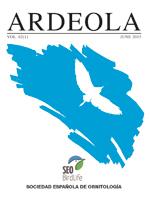Most applied metapopulation studies have focused on habitat structures that are the result of landscape fragmentation but few have studied the dynamics in newly created patches. In artificial habitats, factors determining habitat quality can become especially relevant. Here, we studied the dynamics of linked populations of the little grebe Tachybaptus ruficollis inhabiting a group of irrigation ponds, sited and designed purely for agricultural purposes. We used five years of detection/nondetection data to parametrise incidence function models, in order to analyse the metapopulation dynamics of the species. We aimed to detect the role of pond size, isolation and intrinsic pond characteristics related to the habitat quality (i.e. pond construction design) in determining pond colonisation, extinction and turnover rates. We also used repeated surveys during one year to calculate detection probability of the species in the system. The incidence function model used accurately predicted the proportion of irrigation ponds occupied and detection probability was high (0.88). Little grebes inhabiting the irrigation ponds performed as a metapopulation with extinction events related to pond size and colonisation events related to pond construction design but unaffected by isolation factors. Our simulations highlight the importance of pond construction design in the persistence of the metapopulation and show a simple method for studying the dynamics of a population using detection/non-detection data.
How to translate text using browser tools
1 June 2015
Key Factors Controlling the Metapopulation Dynamics of the Little Grebe Tachybaptus ruficollis in an Artificial Habitat Network of Irrigation Ponds
Esther Sebastián-González,
Karen Luisa Alexander,
José Antonio Sánchez-Zapata,
Francisco Botella
ACCESS THE FULL ARTICLE

Ardeola
Vol. 62 • No. 1
June 2015
Vol. 62 • No. 1
June 2015
ave acuática
detectabilidad imperfecta
humedal
imperfect detection
Tachybaptus ruficollis
waterbird
wetland




